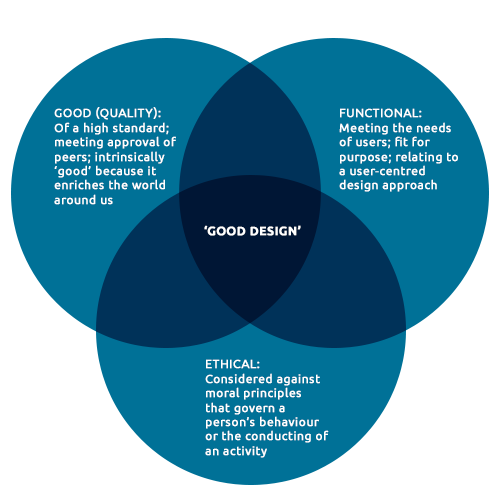What's in a name?
Jo Bailey
January 2014
Section summary
- The name Making Good has several meanings. It suggests fulfilling our commitment; design that is 'good' in the sense of being aesthetically appealing and highly usable; and 'good' in an ethical and moral capacity.
- Good design too can be interpreted in numerous ways.
- This thesis considers good design to encompass ethical, aesthetic and functional facets.
- A purpose of this exegesis is to consider the myriad dimensions of good design as applied to a live, client-facing project.
This, then, is our first question: What is good? and What is bad? and to the discussion of this question (or these questions) I give the name Ethics
(Moore, 1903, chapter 1.2)
What is making good?
This exegesis is called Making Good because:
- It seeks to ‘make good’ on the brief and our commitment to the stakeholders in LAWA .
- It seeks to demonstrate success; to make a mark.
- The act of making is a process, so it acknowledges there is a process to explore.
- As it is called ‘making’, not ‘made’, it also acknowledges this is a work in progress, still in flux.
- It alludes to good design, in terms of its aesthetic and functional merits, and the principles succinctly encapsulated by Dieter Rams in the 1980s.
- It suggests good design in a wider sense, as shorthand for ethical design, and making progress towards that goal (or, at least, understanding what it might mean).
What is good design?
The term 'good design' is generally taken to mean "of a high standard"('Good', n.d.): Design that has aesthetic merit, breaks ground or captures the zeitgeist (Roberts, 2007) and perhaps enriches intrinsically by its very existence. Yet using these criteria, designers could produce work for a morally abhorrent purpose, but still consider it 'good'. Increasingly however, good design as a term has a broader meaning.
Design commentators Steven Heller and Véronique Vienne suggest good design (regardless of style or mannerism) adds value to society, and equate it with good citizenship (Heller & Vienne, 2003). Lucienne Roberts, in her book on ethics in graphic design suggests that in giving a piece of design the accolade ‘good’, we should look beyond “artistic and functional merits” and consider the wider social context:
Does it contribute visually to the world in which we live? … could it be harmful in any way? Is the design efficient in its use of materials and production techniques, and can it be disposed of or recycled without causing harm or involving great cost? Were the producers treated fairly and given proper recompense for the skill and effort provided?
Within this exegesis, good design is used holistically to describe design with due consideration for responsibility, ethics, aesthetics, and fitness for purpose:
 |
Good design: ethical and aesthetic.
Good is personal
There are "lots of different versions of good" (Roberts, 2006, p.11). Each person will place emphasis on the importance of different ethical considerations.
In a conversation with a colleague I learned that he felt that the overarching moral obligation of a designer is similar to that of a lawyer – every client should be entitled to quality design. Most people would find his 'gun for hire' approach extreme, and take a more nuanced line.
As a designer, choosing not to work for certain clients because they operate in a sector to which one has considered moral opposition sounds straightforward. But it is a spectrum, and sometimes not clear-cut (even with a personal ‘engagement policy'). For instance, if you object on principle to mining, deciding not to work for companies engaged in mining is easy, but what about the banks who service them?
Zooming in to the minutiae of design practice and production, myriad decisions could be considered to have an ethical dimension: Is ‘borrowing’ a font without a licence acceptable? Taking images off the web for a mood board even though they are technically copyrighted? Saying yes to an impossible deadline? Taking a quote slightly out of context for more impact? Using non-recycled paper? Everything is on a scale; black and white ethical choices become grey very quickly. How often as design practitioners do we even pause to consider if we are being 'good'?
considering 'good'
Milton Glaser’s 12 Steps on the Road to Hell illustrates beautifully the different magnitudes of ethical decisions we make as designers, and is a valuable aide to establishing “your own level of discomfort with bending the truth”(Glaser, 2002). In a similar way, this exegesis seeks to shine a light into ethical grey areas in a design process, considering decisions through an ethical lens and charting how far down the ‘road to hell’ I went.


